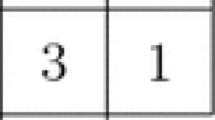Abstract
Our work is devoted to the bijective enumeration of the set of factorizations of a permutation into m factors with a given number of cycles. Previously, this major problem in combinatorics and its various specializations were considered mainly from the character theoretic or algebraic geometry point of view. Let us specially mention here the works of Harer and Zagier or Kontsevich. In 1988, Jackson reported a very general formula solving this problem. However, to the author’s own admission this result left little room for combinatorial interpretation and no bijective proof of it was known yet. In 2001, Lass found a combinatorial proof of the celebrated special case of Jackson’s formula known as the Harer–Zagier formula. This work was followed by Goulden and Nica, who presented in 2004 another combinatorial proof involving a direct bijection. In the past two years, we have introduced new sets of objects called partitioned maps and partitioned cacti, the enumeration of which allowed us to construct bijective proofs for more general cases of Jackson’s formula.
Similar content being viewed by others
References
N. M. Adrianov, “An analogue of the Harer–Zagier formula for unicellular two-color maps,” Funct. Anal. Appl., 31, No. 3, 149–155 (1998).
R. Cori and A. Machi, “Maps, hypermaps and their automorphisms: a survey. I, II, III,” Exposition. Math., 10, 403–427, 429–447, 449–467 (1992).
I. P. Goulden and D. M. Jackson, Combinatorial Enumeration, Wiley, New York (1983).
I. P. Goulden and A. Nica, “A direct bijection for the Harer–Zagier formula,” J. Combin. Theory Ser. A, 111, 224–238 (2005).
A. Goupil and G. Schaeffer, “Factoring n-cycles and counting maps of given genus,” Eur. J. Combin., 19, No. 7, 819–834 (1998).
J. Harer and D. Zagier, “The Euler characteristic of the moduli space of curves,” Invent. Math., 85, 457–486 (1986).
D. M. Jackson, “Some combinatorial problems associated with products of conjugacy classes of the symmetric group,” J. Combin. Theory Ser. A, 49, 363–369 (1988).
M. Kontsevich, “Intersection theory on the moduli space of curves and the matrix Airy function,” Commun. Math. Phys., 147, 1–23 (1992).
B. Lass, “Démonstration combinatoire de la formule de Harer–Zagier,” C. R. Acad. Sci. Paris, Sér. I, 333, 155–160 (2001).
G. Schaeffer and E. Vassilieva, “A bijective proof of Jackson’s formula for the number of factorizations of a cycle,” J. Combin. Theory Ser. A, 115, No. 6, 903–924 (2008).
G. Schaeffer and E. Vassilieva, “Partitioned cacti: a bijective approach to the cycle factorization problem,” in: Proc. of FPSAC’08.
D. Stanton and D. White, Constructive Combinatorics, Springer, New York (1986).
Author information
Authors and Affiliations
Corresponding author
Additional information
Translated from Fundamentalnaya i Prikladnaya Matematika, Vol. 17, No. 4, pp. 25–52, 2011/12.
Rights and permissions
About this article
Cite this article
Vassilieva, E.A., Schaeffer, G. A combinatorial way of counting unicellular maps and constellations. J Math Sci 191, 613–632 (2013). https://doi.org/10.1007/s10958-013-1347-0
Published:
Issue Date:
DOI: https://doi.org/10.1007/s10958-013-1347-0




